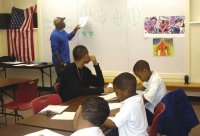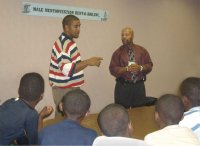For my next blog I would like to explore youth volunteerism and the positive impact that youth volunteers can have for libraries: There are a number of reasons that libraries should enlist and recruit youth’s to volunteer in the library but one of the most important reasons is that it enables libraries to understand youth’s :
Just as successful businesses make decisions based on what their customers want, successful organizations need to do the same. Nike doesn’t design tennis shoes without talking to the athletes who wear them. Organizations too need to be aligned with their target markets. Only teens can tell you what is going on in their lives, what are the pressures they face. “If the problem is gang violence, you go to the teenagers-even to the detention centers-and bring those youths to the table. Anything else is seeds for failure” (McLarney & Leiger, 1997, p. 4)
This illustrates a key theme that we’ve been discussing in class; libraries need to involve youths-it is only then that libraries will be able to understand what they can do to meet the needs of youth so that they can maintain their relevance in the lives of this segment of the population.
In addition to being able to develop a deeper understanding of the diverse needs of youths, libraries will also benefit from the energy, enthusiasm, and perspective that youth volunteers bring to the library. For example, The Canadian Volunteerism Initiative, in cooperation with the Heartwood Centre for Community Youth Development, implemented a youth volunteer project at the Halifax Public Library. In a handbook that resulted from this project entitled, Youth Volunteers at Your Library: Engaging Youth in Your Library, a number of testimonials are provided, which highlight some of the benefits that youth volunteers can have. For example:
“We are just realizing how much the library and community have so much to from youth involvement. It is not just that we have things to give, we also have so much to gain.”
-HPL personnel (2006)
“We have a lot to learn from youth.” -HPL personnel (2006)
“The youth’s energy is so contagious.” -HPL personnel (2006)
This handbook is full of useful information about how to engage youth volunteers, the challenges that may be encountered, and the positive impact that youths can have for the library - I strongly recommend checking it out!
Not only do libraries benefit from youth volunteerism, but youths themselves do as well. Some of the more obvious benefits that youth derive from volunteering at the library include the following: It enables youth to increase their awareness and knowledge of library services and resources, it enables them to develop new skill and increase their employability, youth will be recognized by the library and the community, they will develop a stronger sense of belonging in the library and the community, it will help to enhance their self-confidence, become meaningfully engaged and develop new relationships (Heartwood, 2002, pp. 9)
So how do libraries recruit youth volunteers? This is one area that I think that libraries need to give more attention to. There are a number of resources available both in print and online that can equip librarians with the knowledge and skills that they need to successfully recruit youth volunteers. For example, some of the books that I have came across include Teen Volunteers Services in Libraries (Kellie Gillespie), Library Teen Advisory Groups (Diane Tuccillo), and Connecting Young Adults and Libraries (Patrick Jones). Some of the online resources which may be useful include: The top 10 ways to recruit and enage youth volunteers (World Volunteer Web), Recruiting and Sustaining Youth Volunteers (Canada Volunteerism Initiative) and Tips For Recruitment of Youth Volunteers (Points of Light Foundation). These resources provide readers with a number of useful strategies for reaching youths, such as using mediums which appeal to youth (i.e. the web), dispersing brochures and posters in high traffic areas, recruiting youth for a particular event, recruiting youth indirectly through adults or through other youth volunteers, and becoming visible at places that youths frequent.
I myself feel that one very important way to get youth’s to volunteer in the library is by building stronger connections with local schools. One reason for this is because, as stated in Ontario Secondary Schools, Grades 9 to 12: Program and Diploma Requirements, 1999 (OSS), every student who begins secondary school during or after the 1999–2000 school year must complete a minimum of 40 hours of community involvement activities as part of the requirements for an Ontario Secondary School Diploma (OSSD). Although many students may be aware that the library is a viable option for completing the community service hours, I feel that libraries should be doing more to promote themselves to students as an option. Visiting schools and speaking to students about the benefits that volunteering at the library can have for them as well as the positive impact that they can have on the library as well as their community, may help to spark some motivation in the minds of youth
I recently worked in a library where a number of youths have/are completing their community service hours. I’m not going to lie, I was a little skeptical at first; I thought that their enthusiasm would more than likely be waning because they were being forced to do these community service hours in order to graduate and I also thought that I may get a little bit of attitude from some of them. However, it turns out that these youths are the most enthusiastic, energetic and positive volunteers that I have ever worked with. They really do enjoy being at the library and they really like it when I give them responsibilities and duties. In fact, I think that they respect me more because I am willing to entrust them with these responsibilities; it shows them that I trust them and that I know they are capable of performing these tasks. More importantly, these youth volunteers are great with the library patrons, making every effort to engage with them by asking them if they need help finding anything and by making small talk with them. The patrons really respond positively to this as well.
Overall, youth volunteers are a wonderful asset to the library and I think that all libraries would benefit from developing a deeper recognition of the positive impact that youth volunteers can and do have.
References
Heartwood Centre for Community Youth Development (2002). Youth Volunteers at Your Library. Retrieved December 5, 2008 from http://www.heartwood.ns.ca/tools/YouthVolunteers.pdf
McLarney, M. & Leiger, L. (1997). Younger Voices, Stronger Choices:Promise Project’s Guide to Forming Youth/Adult Partnerships.YMCA of Greater Kansas City.
Ministry of Education and Training. Ontario Secondary Schools, Grade 9-12. Retreived December 5, 2008 from
http://www.edu.gov.on.ca/extra/eng/ppm/124a.html
Posted in Community Outreach, Uncategorized Tagged: volunteerism
















 One of the problems is a lack of suitable role models for boys as they grow up. This problem is recognized in the school system. In a report by Ontario educators, the province was urged to “act immediately to boost the already low and rapidly shrinking number of male teachers” (CBC, 2004).
One of the problems is a lack of suitable role models for boys as they grow up. This problem is recognized in the school system. In a report by Ontario educators, the province was urged to “act immediately to boost the already low and rapidly shrinking number of male teachers” (CBC, 2004). exposure to a teacher typically lasts only one year. Furthermore, boys are required to go to school. Yet it is often observed that boys are not physically present in the library. There is some exciting and innovative library programming to address this issue. The ALA awarded its 2007 Diversity Award to Break-4-Boys: Male-2-Male Mentoring in which men speak and do activities with tweens and teens (ages 11–18) on a consistent basis. Mentorship is performed free for males by males (Nichols & Wilcox, 2007).
exposure to a teacher typically lasts only one year. Furthermore, boys are required to go to school. Yet it is often observed that boys are not physically present in the library. There is some exciting and innovative library programming to address this issue. The ALA awarded its 2007 Diversity Award to Break-4-Boys: Male-2-Male Mentoring in which men speak and do activities with tweens and teens (ages 11–18) on a consistent basis. Mentorship is performed free for males by males (Nichols & Wilcox, 2007).




I could not agree with you more. In our 501 class way back when, we were asked if we thought the librarian stereotype (which is, any way you view it, decidedly female) was a detriment to our profession. And that question has haunted me ever since.
In my mind, the fact that our class was about 20% male spoke for itself. That stereotype — that “real men” aren’t librarians — is horrendously damaging not only to our profession because it belittles the work all librarians do. I read a paper that reported that less than 5% of children’s librarians are male. Correspondingly, boys often replied when asked that they didn’t think they -could- be librarians. I have a friend in his twenties who would love this program but who refuses to try it because he is extremely uncomfortable — “Wouldn’t I be, like, the only guy?”
The idea that men feel they “can’t” become librarians makes me as uncomfortable as women who feel they “can’t” become electrical engineers. It feels really wrong.
And in a rather silly way I almost feel uncomfortable as a woman going into children’s services, because I’m perpetuating a stereotype that excludes 50% of our population. I know it’s silly, but I still think about it.
Hi Kiirstin,
I greatly appreciate your very thoughtful reply and the insights you offer to supplement my post.
It is unfortunate that your friend feels troubled by the prospect of being the only guy. This has never bothered me. In elementary school I was the only male in the choir for two consecutive years.
Apparently the percentage of males in Youth Services is not improving. In the summer our Services for Children and Young Adults class took a tour of the Central Library. I specifically asked about males in the department and recall being told that of all the staff at LPL, only one male works with youth.
Take care,
Michael